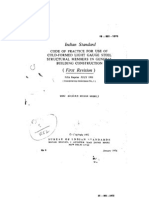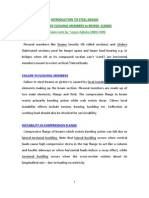IRS Concrete Bridge Code Design Criteria's
IRS Concrete Bridge Code Design Criteria's
Uploaded by
rahulss22Copyright:
Available Formats
IRS Concrete Bridge Code Design Criteria's
IRS Concrete Bridge Code Design Criteria's
Uploaded by
rahulss22Original Title
Copyright
Available Formats
Share this document
Did you find this document useful?
Is this content inappropriate?
Copyright:
Available Formats
IRS Concrete Bridge Code Design Criteria's
IRS Concrete Bridge Code Design Criteria's
Uploaded by
rahulss22Copyright:
Available Formats
IRS Concrete Bridge code Design criterias
Limit State Approach : Refer Clause 10.1,, page V-38 of IRS Concrete Bridge code The usual approach will be to design on the basis of the limit state expected to be most critical and then to check that the remaining limit states will not be reached and that all other requirements will be met. Stress limitation as per limit State of serviceability :
Refer Clause 10.2.2, Table 11, page V-39 of IRS Concrete Bridge code
Temperature Gradient : 11.1.1, page V-40 of IRS Concrete Bridge code
For design of concrete bridges of span 30m and larger, an appropriate temperature gradient shall be considered. In the absence of any data in this regard, depending on the environmental conditions, a linear gradient of temperature of 50C to 100C between the top and bottom fibres may be considered for design. The effect of difference in temperature between outside and inside of box girders shall also be considered in design.
1.
Combination of Loads : Refer Clause 11.2, page V-40 of IRS Concrete Bridge code.
11.2.1.1 Combinations 1 The permanent loads i.e. dead load, superimposed loads etc. together with the appropriate live loads.
Combination 1: DL+SIDL+LL
2.
11.2.1.2 Combinations 2 The load to be considered are the loads in combination 1, together with those due to wind/earthquake, and where erection is being considered temporary erection loads (TEL). Combination 2: DL+SIDL+LL + WL/EQL+TEL(when erection is been considered)
3.
11.2.1.3 Combinations 3 The load to be considered are the loads in combination 1, together with those arising from restraint due to the effect of temperature range and difference and where erection is being considered temporary erection loads (TEL). Combination 3: DL+SIDL+LL+Temperature+TEL(when erection is been considered)
4.
11.2.1.4 Combinations 4 The load to be considered are the permanent loads, together with the loads due to friction at bearings. Combination 4: DL+SIDL+ load due to friction bearings
5.
11.2.1.5 Combinations 5- Dead load, superimposed dead load, together with derailment loads.
Combination 5: DL+SIDL+derailment loads
Loads to be taken in each combination with appropriate Yfl
Refer TABLE 12, (Clauses 11.2 and 11.3), page V-42 of IRS Concrete Bridge code.
Values of Y for the serviceability stress limitations.
M
Refer TABLE 13, (Clauses 12.4.2), page V-44 of IRS Concrete Bridge code NOTE: The higher values for pre-stressed concrete arise because the whole concrete cross section is normally in compression and therefore creep will be greater than in reinforced concrete. Similarly in reinforced concrete creep will be greater where the compressive stress distribution is uniform over the whole cross section.
Values of Y for the Ultimate limit state stress limitations.
M
Refer Clauses 12.4.3, page V-44 of IRS Concrete Bridge code For both reinforced concrete and pre-stressed concrete, the values of Ym applied to the characteristic strengths are 1.5 for concrete and 1.15 for reinforcement and pre-stressing tendons.
Service Life.
Refer Clauses 15.1.3, page V-48 of IRS Concrete Bridge code The bridges shall be designed for the service life as given below: Type of Structure
1. Bridges in sea 2. Bridges in coastal areas 3. Bridges in rest of India Limit State Philosophy.
Design life in Yrs 50 80 100
Refer Clauses 15.2.1 & 15.2.1.1, page V-49 of IRS Concrete Bridge code In general, the design of reinforced concrete members is governed by the ultimate limit state, but the limitations on crack width and, where applicable, stresses at the serviceability limit state given shall also be met. Where a plastic method or redistribution of moments is used for the analysis of the structure at the ultimate limit state, or where critical parts of the structure are subjected to the severe category of exposure, the design is likely to be controlled by the serviceability limit state of cracking.
Drainage of the deck.
Refer Clauses 15.2.2.1, page V-49 of IRS Concrete Bridge code For bridges level in longitudinal profile, minimum cross slopes in the deck shall be kept at 2.5%.
Redistribution of Moments.
Refer Clauses 15.3.2, page V-49 of IRS Concrete Bridge code Redistribution of moments obtained by rigorous elastic analysis under the limit state may be carried out provided the following condition is met;
Checks are made to ensure that adequate rotation capacity exists at sections where moments are reduced, making reference to appropriate test data.
Effective Span.
Refer Clauses 15.4.1.1, page V-50 of IRS Concrete Bridge code
1. The effective span of a simply supported member shall be taken as the smaller
of;
a)
supports; or
the distance between the centers of bearings or other the clear distance between supports plus the effective depth.
b)
Refer Clauses 15.4.1.1.1, page V-50 of IRS Concrete Bridge code
2. The effective span of a member framing into supporting members shall be taken
as the distance between the shear centers of the supporting member. Refer Clauses 15.4.1.1.2, page V-50 of IRS Concrete Bridge code
3. The effective span of a continuous member shall be taken as the distance
between centers of supports except where, in the case of beams on wide columns, the effect of column width is included in the analysis. Refer Clauses 15.4.1.1.3, page V-50 of IRS Concrete Bridge code
4. The effective length of a cantilever shall be taken as its length from the face of
the support plus half its effective depth except where it is an extension of a continuous beam when the length to the centre of the support shall be used.
Points of Zero Moment.
Refer Clauses 15.4.1.2.2, page V-50 of IRS Concrete Bridge code For a continuous beam the points of zero moment may be taken to be at a distance of 0.15 times the effective span from the support.
Slenderness Limits for Beams.
Refer Clauses 15.4.1.3, page V-50 & V-51 of IRS Concrete Bridge code
1. To ensure lateral stability, a simply supported or continuous beam shall be so
proportioned that the clear distance between lateral restraints does not exceed 60bc or 250bc2/d, whichever is the lesser,
2. For cantilevers with lateral restraint provided only at the support, the clear
distance from the end of the cantilever to the face of the support shall not exceed 25bc or 100bc2/d whichever is lesser. Where, d is the effective depth to tension reinforcement; and bc is the breadth of the compression face of the beam midway between restraints.
You might also like
- Demo 50 (ENG) Arihant Encyclopedia of General Science - Siddharth MukherjiDocument50 pagesDemo 50 (ENG) Arihant Encyclopedia of General Science - Siddharth Mukherjimd shoaib100% (1)
- Contractor's Guide for Installation of Gasketed PVC Pipe for Water / for SewerFrom EverandContractor's Guide for Installation of Gasketed PVC Pipe for Water / for SewerRating: 5 out of 5 stars5/5 (1)
- BS en 856-2015Document22 pagesBS en 856-2015leancalidadNo ratings yet
- Examples Bs 8110Document48 pagesExamples Bs 8110Sujith Mathew25% (4)
- Reinforced Concrete Buildings: Behavior and DesignFrom EverandReinforced Concrete Buildings: Behavior and DesignRating: 5 out of 5 stars5/5 (1)
- A Guide To Distribution Theory and Fourier Transforms - Robert S Strichartz - 9780849382734Document222 pagesA Guide To Distribution Theory and Fourier Transforms - Robert S Strichartz - 9780849382734glend_p100% (1)
- Bridge Design ExampleDocument99 pagesBridge Design ExampleNaeem KhanNo ratings yet
- AASTHO Horizontally Curved Steel Girder Highway Bridges 2003 - Part2 PDFDocument28 pagesAASTHO Horizontally Curved Steel Girder Highway Bridges 2003 - Part2 PDFMehedi HasanNo ratings yet
- Structural Connections - Scia5203: Unit - IDocument77 pagesStructural Connections - Scia5203: Unit - IVignesh DhuruvanNo ratings yet
- SAFE Appendix B - Deflection CalculationsDocument9 pagesSAFE Appendix B - Deflection CalculationsMahmood MuftiNo ratings yet
- Serviceability Limit StatesDocument16 pagesServiceability Limit StatesKhaled Fada'aqNo ratings yet
- 03D Attachment - 7 CivilDocument16 pages03D Attachment - 7 CivilJovan RnićNo ratings yet
- Documen JFFFFJJJJJJDocument3 pagesDocumen JFFFFJJJJJJtradingviewaiman01No ratings yet
- Is801 1975Document39 pagesIs801 1975Debasis JagdevNo ratings yet
- Choice of Foundation For BrigdesDocument15 pagesChoice of Foundation For BrigdesSamuel AntobamNo ratings yet
- Bridge 1Document92 pagesBridge 1mohammed_fathelbabNo ratings yet
- How 2 DeflectionsDocument8 pagesHow 2 DeflectionsMisgun SamuelNo ratings yet
- BS5400 Part 4 Training Course - TE EpsomDocument19 pagesBS5400 Part 4 Training Course - TE EpsomjologscresenciaNo ratings yet
- Two Mark QuestionsDocument9 pagesTwo Mark QuestionsNitin SureshNo ratings yet
- 05aDocument41 pages05aBridge Iit At RanchiNo ratings yet
- T Ypes of Structural Composite ElementsDocument25 pagesT Ypes of Structural Composite Elementsshopy99No ratings yet
- Composite Structures Full Notes Part 3 PDFDocument23 pagesComposite Structures Full Notes Part 3 PDFsvnNo ratings yet
- Analysis and Design of Reinforced Concrete Bridge Structures IMPORTANTDocument4 pagesAnalysis and Design of Reinforced Concrete Bridge Structures IMPORTANTAndrea Santillan YzazagaNo ratings yet
- Deflection Calculation of Concrete Floors TN292 PDFDocument38 pagesDeflection Calculation of Concrete Floors TN292 PDFSheik Mohamed LiakathNo ratings yet
- C-27 Piping Flexibility AnalysisDocument32 pagesC-27 Piping Flexibility AnalysisChuy Lee100% (1)
- 3.3.4 LRFD Composite DesignDocument34 pages3.3.4 LRFD Composite Designjosejuanmolina100% (1)
- Serviceability Limit States (SLS)Document62 pagesServiceability Limit States (SLS)Calin Alexandru100% (2)
- MODULE 5 Part I - Design ObjectivesDocument6 pagesMODULE 5 Part I - Design ObjectivesMike Zydrick GatmenNo ratings yet
- Appendix 2 Concrete OverlaysDocument29 pagesAppendix 2 Concrete Overlaysproteor_srlNo ratings yet
- Load Combinations Section 12Document23 pagesLoad Combinations Section 12avikshit yNo ratings yet
- Pull-Out Checks On Anchor Bolts in Anchor Bolt Layouts: Dialog BoxDocument3 pagesPull-Out Checks On Anchor Bolts in Anchor Bolt Layouts: Dialog BoxGothama_GENo ratings yet
- Design of Flexural MembersDocument10 pagesDesign of Flexural MembersOlusegun S. Ajibola100% (1)
- Chapter 10 (6) - BDocument52 pagesChapter 10 (6) - BMahfuzur RahmanNo ratings yet
- S9 DSGN GDLNDocument4 pagesS9 DSGN GDLNDavid CombsNo ratings yet
- How2 Deflections FINALDocument8 pagesHow2 Deflections FINALDiep TuNo ratings yet
- How2 Calulate Deflections Using EC2Document8 pagesHow2 Calulate Deflections Using EC2Amro Ahmad AliNo ratings yet
- Connections in Offshore Deck StructuresDocument19 pagesConnections in Offshore Deck StructuresMadhurimaMitraNo ratings yet
- Notification 53Document26 pagesNotification 53Saurav TalukdarNo ratings yet
- Design Detail To Bs 8110 1997Document32 pagesDesign Detail To Bs 8110 1997Duke Thibbotuwawa0% (2)
- RCC Short NotesDocument5 pagesRCC Short Notesashok pradhanNo ratings yet
- Design of Reinforced Concrete Elements For Serviceability Limit State-1Document16 pagesDesign of Reinforced Concrete Elements For Serviceability Limit State-1Sayed TahaNo ratings yet
- Shrinkage, Cracking and Deflection-The Serviceability of Concrete 1Document25 pagesShrinkage, Cracking and Deflection-The Serviceability of Concrete 1Rajat Mangal100% (1)
- IS 203 Pipe Deflection PDFDocument5 pagesIS 203 Pipe Deflection PDFjustinctlNo ratings yet
- 3.6 Longitudinal DesignDocument22 pages3.6 Longitudinal DesignglaydelleNo ratings yet
- Circular Hollow Sections PDFDocument28 pagesCircular Hollow Sections PDFangie_leo5374No ratings yet
- Is 3370 - 1Document20 pagesIs 3370 - 1Umesh ChikhlikarNo ratings yet
- Design & Detail To BS 8110-1997Document32 pagesDesign & Detail To BS 8110-1997Brukadah Williams Onwuchekwa93% (28)
- Bridge Girders-Strength at TransferDocument11 pagesBridge Girders-Strength at TransferAndy AcousticNo ratings yet
- Well CompletionDocument82 pagesWell CompletionFlorian Ananias ByarugabaNo ratings yet
- Appendix C. Rating Procedure For Existing BridgesDocument4 pagesAppendix C. Rating Procedure For Existing Bridgesliamo8888No ratings yet
- DeflectionDocument22 pagesDeflectionrobertantoreniNo ratings yet
- Crack - Width of Flexural RC Members-ICJ-Nov05Document6 pagesCrack - Width of Flexural RC Members-ICJ-Nov05Munish BansalNo ratings yet
- Cylindrical Compression Helix Springs For Suspension SystemsFrom EverandCylindrical Compression Helix Springs For Suspension SystemsNo ratings yet
- A Short Guide to the Types and Details of Constructing a Suspension Bridge - Including Various Arrangements of Suspension Spans, Methods of Vertical Stiffening and Wire Cables Versus Eyebar ChainsFrom EverandA Short Guide to the Types and Details of Constructing a Suspension Bridge - Including Various Arrangements of Suspension Spans, Methods of Vertical Stiffening and Wire Cables Versus Eyebar ChainsNo ratings yet
- Some Mooted Questions in Reinforced Concrete Design American Society of Civil Engineers, Transactions, Paper No. 1169, Volume LXX, Dec. 1910From EverandSome Mooted Questions in Reinforced Concrete Design American Society of Civil Engineers, Transactions, Paper No. 1169, Volume LXX, Dec. 1910No ratings yet
- How to prepare Welding Procedures for Oil & Gas PipelinesFrom EverandHow to prepare Welding Procedures for Oil & Gas PipelinesRating: 5 out of 5 stars5/5 (1)
- Internal Combustion Engine Bearings Lubrication in Hydrodynamic BearingsFrom EverandInternal Combustion Engine Bearings Lubrication in Hydrodynamic BearingsNo ratings yet
- Coulombs LawDocument10 pagesCoulombs LawEPHREM TEDLANo ratings yet
- Electrostatic 1 (Mcq. For Board)Document9 pagesElectrostatic 1 (Mcq. For Board)Sheetal meenaNo ratings yet
- CDS & CDS Ota 15 Years GSDocument336 pagesCDS & CDS Ota 15 Years GSRahul NagawadeNo ratings yet
- Electromagnetic Field Theory and Transmission Lines G. S. N. Raju 2024 Scribd DownloadDocument54 pagesElectromagnetic Field Theory and Transmission Lines G. S. N. Raju 2024 Scribd DownloadtsanhjuryNo ratings yet
- Nanolithography and Device Fabrication: Fall 2020/2021 NilDocument29 pagesNanolithography and Device Fabrication: Fall 2020/2021 NilRashail AshasNo ratings yet
- Key Application of EllipseDocument6 pagesKey Application of Ellipsesherilyn palacayNo ratings yet
- Fundamentals of Mass and Energy BalancesDocument15 pagesFundamentals of Mass and Energy BalancesdeltaoperativNo ratings yet
- Refraction TestDocument3 pagesRefraction TestVaishakh VarierNo ratings yet
- The New prEN 15193-1 To Calculate The Energy RequiDocument8 pagesThe New prEN 15193-1 To Calculate The Energy RequiEsraa KhairyNo ratings yet
- 102 Design Original TemplateDocument4 pages102 Design Original TemplaterespiraahoraNo ratings yet
- Functions - CAPSDocument70 pagesFunctions - CAPSzaahirahabrahams786No ratings yet
- ME3351 - Engineering Mechanics QB 01 - by WWW - Notesfree.inDocument32 pagesME3351 - Engineering Mechanics QB 01 - by WWW - Notesfree.inMd. Zishanur RahmanNo ratings yet
- Jacking Force of Continuous Rigid Frame Bridge On High TemperatureDocument4 pagesJacking Force of Continuous Rigid Frame Bridge On High TemperatureTamaduianu IoanNo ratings yet
- Thermal Analysis and Rheology in Polymer AM V1 2023Document120 pagesThermal Analysis and Rheology in Polymer AM V1 2023k2sv4zfcp9No ratings yet
- Some Best Questions On TrigonometryDocument4 pagesSome Best Questions On TrigonometryRaghav MadanNo ratings yet
- 2 Science 8 Curriculum MapDocument2 pages2 Science 8 Curriculum MapMayumie RelataNo ratings yet
- Assignemnt 1-Material ScienceDocument1 pageAssignemnt 1-Material ScienceMohit NarayanNo ratings yet
- ExcerptDocument10 pagesExcerptbeverly.abuan20No ratings yet
- MahanDocument792 pagesMahanoliv.massetNo ratings yet
- Jlpea 08 00023 PDFDocument20 pagesJlpea 08 00023 PDFKarim BNo ratings yet
- Prestressed Concrete Fencing PostsDocument3 pagesPrestressed Concrete Fencing Postsexi johnsonNo ratings yet
- Distribution and Loss Functions: Alex RobinsonDocument20 pagesDistribution and Loss Functions: Alex RobinsonAlex RobinsonNo ratings yet
- 2.2 SAMPLE CertificateDocument1 page2.2 SAMPLE Certificatesathishkumar812269No ratings yet
- Sample Paper 11Document8 pagesSample Paper 11shikhaok16No ratings yet
- MENSURATIONDocument24 pagesMENSURATIONKeshav AgarwalNo ratings yet
- Sample Problems PhysiDocument13 pagesSample Problems PhysiSaeym SegoviaNo ratings yet
- MS 02 Asphalt Mix Design, 7th Edition, 2014Document2 pagesMS 02 Asphalt Mix Design, 7th Edition, 2014Shafiqullah GowharyNo ratings yet

























































































